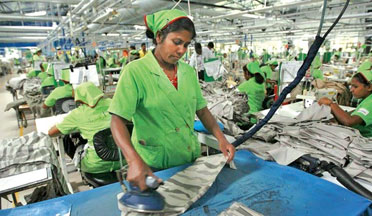Trade agreements: Time to re-evaluate
Once upon a time Sri Lanka was at the forefront of South Asian trade
liberalisation. Beginning in 1989 Sri Lanka made large reductions in
import duties, and by 2001 Sri Lanka's average applied import duty was
down to 9.1% compared to India's 32% and Pakistan's 20%.
 |
|
At the peak of trade
agreements: Inside a garment factory |
 Sri Lanka was also the prime mover in South Asian trade agreements
with the Indo-Lanka FTA of 2000. Sri Lanka was also the prime mover in South Asian trade agreements
with the Indo-Lanka FTA of 2000.
It would have also been the first in South Asia to enter a trade
agreement covering services and investment had it stuck with the 2004
deadline set by the Joint Study Group for the Indo-Lanka Comprehensive
Economic Partnership Agreement (CEPA).
All along economic analysts smiled upon these developments. Sri Lanka
was seen as a beneficiary of its boldness.
But that was the past. The times have changed; and so have the
economists.
Sri Lanka still has the lowest average import duty in South Asia, but
effective protection has been increasing. Ad-hoc levies such as the
special commodity levy, port and airport levy, and import cess has been
on the rise in the last decade.
The gaps are also narrowing. In 2011 average import duty of Sri Lanka
stands at 10.2 (higher than 2001 levels), India at 12.6% and Pakistan at
13.9%.
If that seems a little bit odd, here is where it becomes downright
puzzling. Free Trade Agreements with Asian countries have been moving up
in the last 10 years, and Sri Lanka has been missing it all. By the
beginning of 2013 there were 546 WTO notified trade agreements, of which
354 were in force and others being negotiated. In the past 10 years,
with nearly 100 operational agreements and another 150 under
negotiation, Asia has surged to account for nearly half of the global
trade agreements.
 This proliferation of trade agreement is driven both by Asian
economies trying to tap each other's markets and non-Asian economies
attempting to expand in Asia's large and fast growing consumer markets. This proliferation of trade agreement is driven both by Asian
economies trying to tap each other's markets and non-Asian economies
attempting to expand in Asia's large and fast growing consumer markets.
This means Asia is fast closing in on the developed countries in
terms of its share in global trade. By 2012 just six Asian countries
accounted for nearly a quarter of global trade.
Once a prime mover in terms of trade agreements, Sri Lanka is now
getting left behind in Asia. It is only doing better than those
classified as Least Developed Countries (LDCs) in South Asia.
Since 2005 India has signed Comprehensive Economic Partnership
Agreements with Singapore, ASEAN, South Korea, Japan and Malaysia. Many
more are being negotiated. Overall, India has 13 agreements that are
operational and 21 under negotiation. But the Indo-Lanka CEPA is on the
backburner without a deadline.
Not having fun with trade
The puzzle deepens. Not only is Sri Lanka lagging behind in Trade
agreements, it is not getting much out of the agreements it has, either.
Sri Lanka has five trade agreements that are operational and three
agreements under negotiation.
All of them are with Asian countries including India, South Korea and
even China. Yet, exports to these countries, other than India, are
rather small. For example as a percentage of total exports Pakistan
accounts for just 0.8%, Bangladesh 0.6%, the Maldives and South Korea
just 0.5% each, and China 1.2%. Even more discouraging to Sri Lanka is
the fact that it imports heavily from Asia, and exports so little.
Among the top ten countries from which Sri Lanka imports, eight are
Asian countries and they account for 57% of total imports. But only 13%
of Sri Lankan exports reach these same markets leading to a trade
deficit with them that can be as high as $10 billion.
There are two reasons why existing agreements have not delivered.
First is low coverage and limited depth of concessions of existing
agreements (other than the agreement with India). APTA's product
coverage in which South Korea and China are members is poor and the
preferential margin is low. The GSTP is even more restrictive than APTA
in terms of product coverage and concession levels. SAFTA has very long
tariff phase out periods for LDCs and relatively large negative lists.
Second, Sri Lanka's trade agreements are still restricted to trade in
goods. All recent agreements signed by developed and developing
countries go beyond trade in goods to cover a number of other areas such
as services, investment, competition and intellectual property. For
example, to date there are 117 agreements notified to WTO covering trade
in goods and services.
Time to take stock
There can be good reasons to not liberalise trade. For instance, it
can be important to protect vulnerable farming sectors and develop
nascent industries. But there is no evidence that Sri Lanka's direction
change in trade liberalisation is resulting in such positive benefits.
Sri Lanka is no longer a mover of trade agreements in Asia. Its
export access to Asia (except India) is anaemic relative to its imports.
What is the policy direction for trade and what are the positive
benefits being pursued? The data says that it is time to take stock and
re-evaluate.
Verité Research provides strategic analysis and advice for
governments and the private sector in Asia. |


